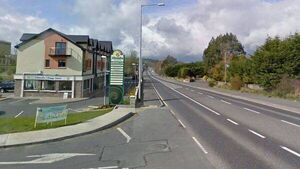Villagers object to ‘an industrial Kilmeaden'

Kilmeaden village where plans for an industrial-scale data and energy hub have been submitted to the planning department of Waterford City and County Council.
A recent planning permission application for a major technology park in Kilmeaden has sparked controversy in the village community. The planning permission application was submitted by Crag Rathnew DC Limited and Kent Homes Limited. Kent Homes Limited have been involved in several development projects in Kilmeaden, including the Clochan Housing Development.
If the application is approved, the site will cover 108.79 hectares, making it the largest development in Kilmeaden’s history.
Local Councillor John O’Leary says he “doesn’t want to see it overwhelming Kilmeaden”.
His main objection to the proposal is that “good land should not be used for data centres”, and expressed concern that farming land is being increasingly used for technology parks and solar farms.
He thinks that data centres are “more viable” in industrial estates. Referring to the numerous objections that have been raised by local residents, he said, “It is my responsibility to listen to the local people.” The majority of the site will consist of solar panels, an extensive data centre, and a car park, with a small portion of the site being dedicated to a new village centre.
While the planning application emphasizes sustainability, locals are not convinced.
So far, 67 objections have been submitted to Waterford City and County Council.
One objector wrote, “This proposal represents an industrial-scale data and energy hub disguised as a mixed-use ‘village centre’.” Indeed, the three two-storey ICT facilities will be 77,099sqm, whilst the 48-unit apartment block will be just 5,374sqm.
Another resident wrote that, “the ecological impacts to the area’s biodiversity will be devastating. Trees will be cut, hectares of grass paved over, native species obliterated.”
According to the Environmental Impact Assessment Report (EIAR), the plan would have the potential to "interfere with the balance, distribution and density of key species".
However, the area itself is not a protected wildlife site. Natura 2000 sites are European Union protected wildlife sites. There are currently no Natura 2000 sites in the Kilmeaden area, but there are Natura 2000 sites in the Comeragh Mountains and Tramore.
Yet another resident wrote that the proposal is, “purely a money-making scheme for Kent construction.” The grassroots community group known as ‘Say No to an Industrial Kilmeaden’ are going door-to-door in the Kilmeaden area, encouraging residents to submit objections to Waterford City and County Council.
They have organised a meeting for this Sunday, October 5, at the Ballyduff Community Centre where they say they will help people write their submissions.
The deadline for submissions is October 12 and it is expected that the council will announce their decision by November 2.
The group wrote that the outcome of this proposal, “will set the benchmark of what’s to come in the future”.
The majority of the objections are concerned with the environmental impact that the development will have on the village. Included in the plan are 16 gas turbines, which, according to the United States environmental defense fund, “Gas turbines burn natural gas and create several dangerous types of pollution, including Nitrogen Oxides (NOx) that cause smog and soot, climate change-causing greenhouse gas pollution, and hazardous air pollutants that have been linked to cancer”.
However, the turbines will be necessary to power the technology park also planned.
According to the Central Statistics Office, data centres accounted for approximately 21% of Ireland’s total electricity usage. This is significantly higher than other European countries, with the Netherlands being the next highest at 5.2%. In 2044, 80% of Ireland’s energy usage was sourced from fossil fuels. Data centres have been proven to damage the environment. The Journal found that 130,000 tonnes of C02 were released into the air from just one data centre in Lucan since 2017.
The planning application states that it aims to be the first village centre in Ireland to be 100% fossil-fuel free. However, the energy report states that the solar panels will only "partially offset the power demand from the ICT facilities”.
According to the same report, just 20% of the energy used on the site will be renewable. It says, “the energy consumption and CO2 associated with the data storage halls are not taken into account” due to regulations surrounding renewable energy and new builds not applying to "specialist buildings" such as data centres.
However, the application states that the applicant has, “proactively engaged with multiple renewable energy providers to ensure that the proposed development will operate sustainably.” It also states that it will generate more electricity than it will use, thus adding renewable energy to the grid. This will be primarily sourced from the solar farm also planned for the sight.
According to the EIAR, the gas turbines are designed to provide 203 MW to match the capacity of the proposed data centre demand. The gas used by the gas turbines will be hydrotreated vegetable oil.
Hannah Daly, a professor in sustainable energy in UCC told The Journal that using natural gas, such as hydrotreated vegetable oil, is “far more carbon intensive than electricity from the grid”. The solar farm will produce 29 MW.
According to the planning permission application, “the proposed development has been designed so as to reduce impacts to climate once operational and where possible”.
Due to the large size of the proposed data centre and according to the EU Emissions Trading System, the development will be required to hold a Greenhouse Gas Emissions permit and report their emissions each year.
This means that in order to comply with EU regulations, it will need to purchase carbon credits to offset its emissions.
Locals also say the glint and glare from the solar panels will make driving dangerous, and they are also concerned that the car park floodlights will be on 24/7.
They went on to write that, “the project has been advanced with no meaningful community consultation prior to submission. Residents of Kilmeaden were not contacted, no public information sessions were held, and no opportunity was given to shape the proposal before it was finalised”.
“For a project of this unprecedented scale and industrial nature, the absence of community engagement is unacceptable and further undermines the legitimacy of the application,” they said.
The developer was reached for comment but had not responded at the time of publication.






